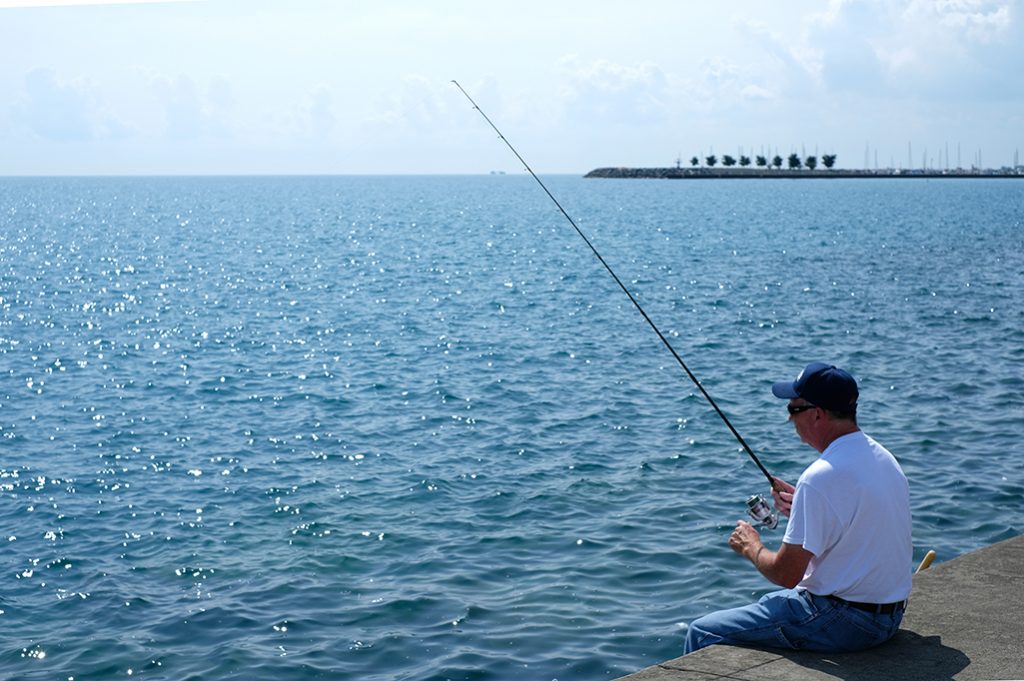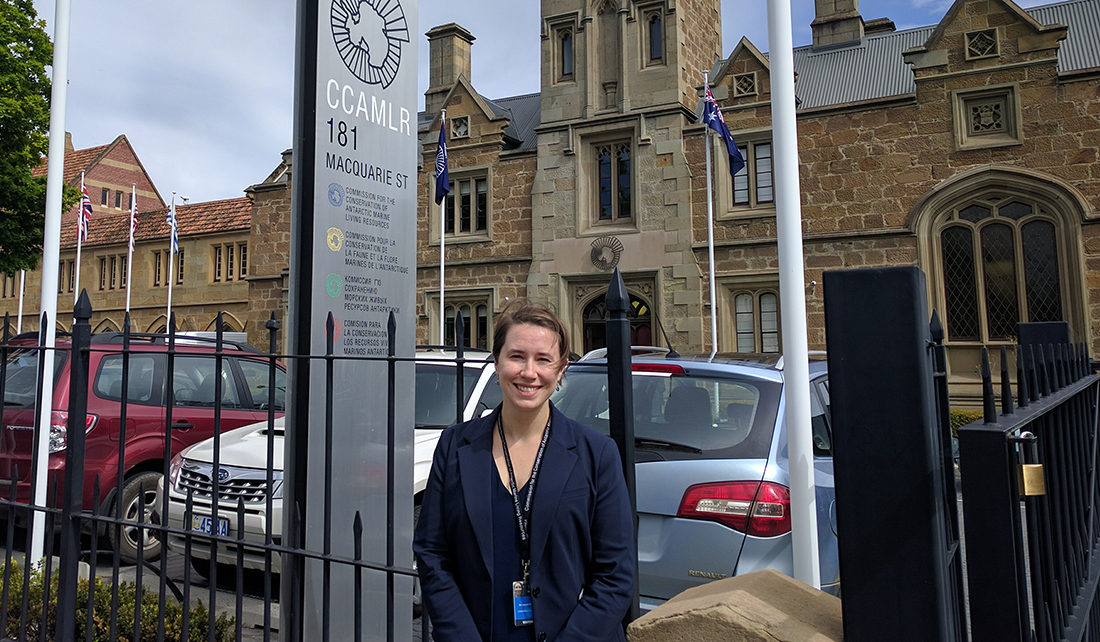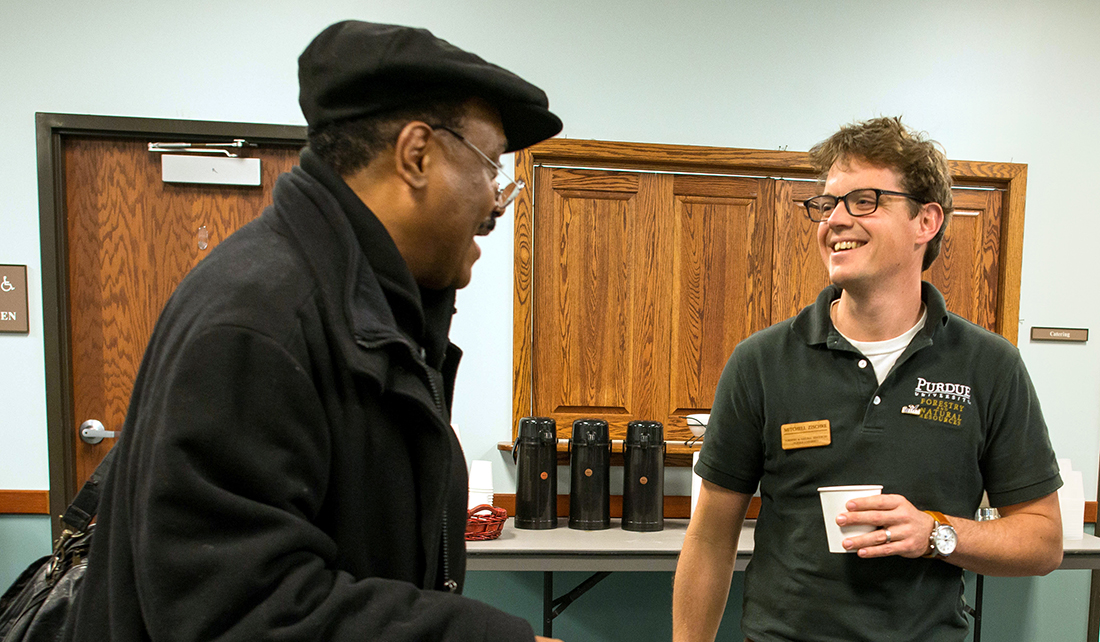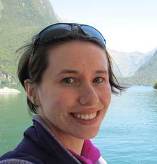August 29th, 2018 by IISG
Evolution is often viewed through the lens of thousands of years. But it may have taken humans only a century or so to force evolutionary changes to fish in the Great Lakes, according to a Purdue University report.
Environmental factors over long periods of time often lead to beneficial traits in animals. But Tomas Höök, a professor in the Department of Forestry & Natural Resources at Purdue University and director of Illinois-Indiana Sea Grant, and colleagues believe there is evidence of fisheries-induced evolution (FIE) in the Great Lakes.
“Fishing and harvesting creates strong pressure that could select for certain genetic material in a fish population and lead to rapid human-induced evolution of the population,” Höök said.
A review, published in the Journal of Great Lakes Research, presents the case for rapid evolution, including case studies of two important fishery species — yellow perch and lake whitefish.
For yellow perch, Lake Michigan commercial fishing operations in the early 1990s overharvested perch, in particular large female fish. This led to an abundance of male fish as well as smaller females, since they were the most likely to have an opportunity to reproduce.
After a collapse of yellow perch populations, commercial fishing for the species was shut down and recreational angling for the species was restricted. Research shows that yellow perch quickly started to sexually mature later and at larger sizes once they weren’t susceptible to harvest.
“Importantly, this research suggests that FIE can occur rapidly, but that changes are reversible,” wrote the authors, which included Erin Dunlop from the Ontario Ministry of Natural Resources and Forestry, as well as Zachary Feiner and Höök from Purdue.
Lake whitefish populations have been affected by overfishing and invasive species in Lake Michigan and Lake Huron. Models suggest that high harvest rates and harvesting before whitefish reach sexual maturation could lead to rapid declines in population and the size at which fish mature.
Höök said fisheries-induced evolution has been widely studied in marine systems, but more needs to be done on freshwater species since many can be important ecologically and commercially.
“We need to assess the potential for fisheries-induced evolution in these systems to better understand the extent to which fishery managers can and should think about FIE when making key management decisions affecting fish populations,” Höök said.
August 22nd, 2018 by iisg_superadmin
The economic impact of the Illinois and Indiana Lake Michigan recreational fishery on the local economy was more than $44 million in 2015, according to Illinois-Indiana Sea Grant (IISG) research. Recreational fishing supported 407 jobs in the two states.
IISG funded two studies to estimate the economic value of the Lake Michigan fishery in Illinois and Indiana. At the Illinois Natural History Survey (INHS), Sergiusz Czesny, Craig A. Miller, and graduate student Elizabeth Golebie looked at how much anglers actually spend and estimated the impact of those dollars.
They questioned anglers about their typical fishing trip expenses and found that shore-based anglers spent an average of $56 and boating anglers spent $255. Annual creel surveys, which are done in person along the shoreline, provided a point of contact so that the researchers could target their questionnaires to anglers who fish in Lake Michigan. In Illinois, INHS is responsible for the creel surveys along the shoreline in Cook and Lake counties. In the Indiana counties of Lake, Porter and LaPorte, the creel surveys are done by the state’s Department of Natural Resources.
The researchers estimated the total economic impact of Lake Michigan non-charter anglers in Illinois waters at $22.4 million, providing 231 jobs. Indiana non-charter anglers contributed $12.7 million to the local economy, supporting 176 jobs in the three counties. Illinois charter fishing anglers were also included in this study and comprised the remaining economic impact that altogether totaled more than $44 million.
“There’s a wide range of economic activity going on with fishing,” said Miller. “These numbers provides more evidence that we need to maintain these fisheries. Several sectors of the economy are dependent on a healthy fishery with healthy fish populations and angler access.”
In both states, the overwhelming majority of fishing—75 percent—was for salmon species, which include coho and chinook salmon, as well as brown, lake and rainbow trout. Only 6 percent was dedicated to yellow perch, and the remainder for other species, such as bass.
Mitchell Zischke and graduate student Xiaovang He at Purdue University, and Benjamin Gramig at the University of Illinois tell more of the story in their economic evaluation research. Using a non-market approach to quantifying the value of the Lake Michigan fishery in the two states to the anglers themselves, they estimated anglers’ willingness to pay for a day-trip spent fishing. They added questions to the 2015 Illinois and Indiana creel surveys to do a travel cost study, estimating the value of fishing based on how far anglers traveled and how much time it took to get to fishing sites.
“In addition to direct expenditures, anglers allocate time and effort to fishing instead of work or other activities, and this is the basis for these estimated values,” said Gramig.

Anglers interviewed during the 2015 creel surveys along Lake Michigan were willing to pay an average of $30 to take a day trip fishing and their average travel distance was 28 miles. Illinois anglers have a slightly higher willingness to pay than those from Indiana and boaters have a higher average, at $40, than shore-based anglers, who are willing to pay $26.
The total estimated non-market economic value of recreational fishing was $3.6–4.0 million, which represents additional value over and above expenditures on food, fishing supplies and other associated items included in Miller and Czesny’s estimates.
“Support for the economy through recreational fisheries is a complex web,” said Zischke. “Having some understanding of these numbers is important. For example, if there’s a potential to open up a fishing site, it’s critical to know that it may add millions of dollars to the economy.”
Zischke and Gramig also looked at 30 years of creel survey data to get a historical perspective on the Lake Michigan fishery and connect trends with environmental or management changes.
The data revealed that while the two states share Lake Michigan waters, they have noteworthy differences in fishing practices. “We noticed a large decline in the fishing effort in Illinois,” said Zischke. Fishing effort back in the mid-1980s added up to over 2 million angler hours per year—since the early 2000s it has stabilized at 500,000 annual angler hours.
Zischke attributes the reduction in Illinois fishing hours to the drop in yellow perch numbers. “The decline in fishing effort follows a similar timeline to declines in catch rates of yellow perch,” he said.
“In Indiana, however, we did not find a similar decline in fishing hours,” said Zischke. “Fishing hours have been stable at 300,000–400,000 over the last 30 years. Typically, the catch rates of yellow perch in Indiana have been historically lower than in Illinois and they have actually been quite stable through time.”
The historical creel survey data also revealed that most Illinois anglers have engaged in shore-based fishing, whereas Indiana anglers have been predominantly on boats. This may be due to the fact that Illinois has a higher population along the lakefront and more access to fishing along its shores.
The research team has made the creel surveys’ 50,000 records collected from 1986 to 2013 available for other researchers, resource managers and anglers to easily access on the Angler Archive website. Plans are in the works to update the website with more recent data.
January 17th, 2017 by IISG
August to November of my John A. Knauss Marine Policy Fellowship was non-stop. I have been learning about international fisheries policy in my placement within NOAA National Marine Fisheries Service, Office of International Affairs and Seafood Inspection Program all year and it was time to see it in action. My travels took me to five countries on three continents for five, very different international meetings.
Using the professional development funds provided by the fellowship, I traveled to Kuala Lumpur, Malaysia in August for the 34th meeting of the Scientific Committee on Antarctic Research (SCAR). The conference was directly related to my doctoral thesis work and also tied in with work that NOAA Fisheries does in the Southern Ocean on the United States delegation to the Commission for the Conservation of Antarctic Marine Living Resources (CCAMLR). Many scientists from other nations’ delegations were also present at the SCAR meeting and it was an incredible opportunity to meet international Antarctic researchers, many of whom I would see two months later in Hobart, Tasmania for the 35th meeting of CCAMLR.

Lauren in Tasmania, Australia at Commission for the Conservation of Antarctic Marine Living Resources (CCAMLR).
I thought central Illinois and Washington, D.C., were hot and humid during August and that I was well prepared for August in Kuala Lumpur. It turns out that a few higher percentage points of humidity make a huge difference in comfort level. Thankfully my hotel was connected to the convention center, meaning trips outside could be planned strategically. I was also fortunate to be staying at the same hotel as the U.S. delegation to SCAR and they welcomed me into their morning breakfast meetings to learn more about the inner workings of the conference organization.
The conference itself was not only a great way to keep up on the current research in my field of fish physiology but also learn about areas of Antarctic research that I had previously never considered on topics as wide-ranging as algal ecology to architecture and literature. There were a number of panels and sessions devoted to scientific advice for policy which is a topic that is extremely relevant to the Knauss Marine Policy Fellowship as well as my role in my fellowship office. Many of the topics discussed would make a second appearance two months later during the CCAMLR meeting.

Malaysia tea plantation
The 2016 CCAMLR meeting in Hobart, Tasmania was an exciting meeting to attend. Many of the species I was familiar with from my doctoral work were discussed in terms of conservation or fisheries catch allocation in regions of the Southern Ocean that I was familiar with. One of my largest projects of my fellowship year was drafting a background paper for the U.S. delegation to present to CCAMLR on incorporating independent review of fisheries stock assessments in the CCAMLR convention area.
I was able to be in attendance as a member of the U.S. delegation and see this paper brought to the floor in front of the 24 member nations and the European Union and discussed. The most exciting event to come out of the meeting, however, was the passing and adopting of the Ross Sea Marine Protected Area, a 1.55 million square kilometer section of the Southern Ocean set aside for conservation. This proposal, which is also the world’s largest marine protected area, was six years in the making and its adoption was met with applause, hugs, and tears from the nearly 250 people in attendance at the meeting. It was an emotional and exciting meeting to be a part of.
My fellowship is coming to an end, but I will be continuing my work with NOAA Fisheries as a full-time employee and foreign affairs specialist beginning on January 23. I am so grateful for the experience and training that this fellowship has provided to me this year.
Please visit the Fellowship and Scholarship page for more opportunities.
Illinois-Indiana Sea Grant is a part of University of Illinois Extension and Purdue Extension.
November 16th, 2016 by IISG
The first of hopefully many recreational fishing workshops brought together more than 40 researchers, managers, stakeholders, and anglers last week to Hammond Marina in Indiana to learn about food web research, updates on fisheries, and ongoing monitoring in southern Lake Michigan.
Mitchell Zischke, IISG research and extension fishery specialist, organized the event.
“I have presented research at similar workshops for Lake Huron hosted by Michigan Sea Grant. These workshops were well attended and a great opportunity for anglers, scientists, managers, and others to interact,” said Zischke. “I wanted to develop a similar program for southern Lake Michigan, particularly in light of recent ecosystem and fishery changes like the declining populations of alewife.”
The five speakers hailed from NOAA Great Lakes Environmental Research Laboratory, U.S. Geological Survey Great Lakes Science Center, U.S. Fish and Wildlife, Ball State University, and Illinois Natural History Survey.

Mitchell Zischke, IISG research and extension fishery specialist, pictured on the right, organized the event.
Topics included recent changes in the base of the food web, status and trends of prey fish, mass-marking of Chinook salmon and lake trout, long-term monitoring of yellow perch, and angler surveys and the recreational fishery focusing on the Illinois waters of Lake Michigan.
Howard Petroski, known as “Captain Ski,” ran Paradise Charters out of East Chicago for 25 years until it shut down about 14 years ago. Even though he now just fishes recreationally, he still follows what’s happening in Lake Michigan.
“What they’re showing with the decline of the perch was pretty obvious, but now it’s more obvious that they showed it on the charts,” Petroski said.
According to Zischke, this first workshop just scratched the surface on topics relevant to anglers in southern Lake Michigan.
“There were actually more people willing to present than I could fit in the workshop agenda. We hope that these workshops can become an annual event in both Indiana and Illinois, that way we can continue to provide anglers and other lake-users with up-to-date information on the Lake Michigan fishery and ecosystem as a whole. In fact, attendees at our recent workshop said that they can’t wait for the next one!”
Illinois-Indiana Sea Grant is a part of University of Illinois Extension and Purdue Extension.
September 12th, 2016 by IISG
We’re excited to welcome Mitchell Zischke, our new research and extension fishery scientist! He will be located at Purdue University’s West Lafayette campus. The focus of his research, extension, and teaching program is the biology, ecology, and socioeconomics of fisheries.
“I’m excited to be joining the IISG team. It’s great to be part of such a diverse team working towards conserving and promoting Lake Michigan,” Mitchell said.
“The southern shores of Lake Michigan with its tall dunes, white sand, and blue water reminds me quite a bit of the east coast of Australia—well except for the coral reefs and animals that can kill you…”
Mitchell’s work primarily focuses on the Great Lakes where he employs laboratory and field-based tools to explore population dynamics and ecology of fish species such as lake whitefish, walleye, yellow perch, and salmonid species. He also uses survey data to explore changes in recreational fishery characteristics such as catch rates and angler satisfaction. His extension program aims to increase communication among fisheries, researchers, managers, and other stakeholders by hosting public workshops and developing products such as online data portals.
Mitch also has extensive experience in tropical marine fish and fisheries. He has conducted research on pelagic species such as wahoo, mackerel and tunas, and estuarine species such as blue threadfin. He was worked for state and federal fishery management organizations in Australia.
Mitchell obtained a Bachelor of Science (honors) majoring in tropical marine science in 2006 and a PhD in fisheries science in 2013, both from the University of Queensland in Brisbane, Australia.
Illinois-Indiana Sea Grant is a part of University of Illinois Extension and Purdue Extension.
December 7th, 2015 by iisg_superadmin
In late November, the 2016 Knauss Fellowship finalists from around the Sea Grant network met in Washington D.C. for a week to sort out where each will be working in the coming year. Over the week, the finalists interview for positions and try to match their skills and interests with agencies and legislators who are also looking for just the right person.
The Knauss fellowship provides a unique educational experience to students who have an interest in ocean, coastal and Great Lakes resources and in the national policy decisions affecting those resources. The program matches highly-qualified graduate students with “hosts” in the legislative and executive branches of government for a one year paid fellowship. This year, IISG had two finalists attending placement week.
Lauren Fields, who recently finished her PhD at the University of Illinois, will be a foreign affairs fellow with NOAA Fisheries Office of International Affairs and Seafood Inspection. This position reflects her long dedication to fish biology in the Antarctic waters. She has a particular interest in the Antarctic toothfish.

A Purdue University graduate, Sarah Stein will also be involved with NOAA fisheries work. For the year of 2016, she will hold the titles of executive secretariat and fisheries science coordinator in the Fisheries Office of Science and Technology. Sarah also has a rich history studying fisheries, but with a local focus. Her PhD dissertation study was centered on fish recruitment in southern Lake Michigan river mouth habitats.
If you are interested in applying to be a Knauss fellow, the deadline for 2017 positions is February 12. Visit our
Fellowship page for more information on this and other fellowship opportunities.
February 5th, 2015 by iisg_superadmin
Fisheries managers have long known that the population of rainbow smelt in the Great Lakes is on the decline. Once so abundant that they could be fished out with a pot or strainer, this important prey fish survives today in numbers hovering near historic lows. Numerous causes for the falling population have been proposed, but new research suggests that the population patterns and the forces driving them are more complicated than previously believed.
 The 2014 study reveals that number of smelt that survive their first few months has actually been on the rise since 2000. But this increase in hatchlings isn’t translating into more adults, and it is unclear when and why that breakdown is happening. Whatever the cause, the loss of adult rainbow smelt is enough keep the population trending down even as offspring survival improves.
The 2014 study reveals that number of smelt that survive their first few months has actually been on the rise since 2000. But this increase in hatchlings isn’t translating into more adults, and it is unclear when and why that breakdown is happening. Whatever the cause, the loss of adult rainbow smelt is enough keep the population trending down even as offspring survival improves.
Researchers from USGS, IISG, Purdue University, and the U.S. EPA Great Lakes National Program Office, discovered the unexpected increase in offspring after analyzing roughly 40 years of fisheries data using a novel modeling technique.
Fish populations are typically analyzed using a statistical model that that assumes the relationships between different variables—things like number of offspring, number of adults, degree of predatory pressure, and amount of rainfall—remain the same over time. For this study, researchers used statistical tools rarely used by fishery scientists that better reflect the ever-changing nature of the Great Lakes and make it possible to detect more subtle population patterns.
Perhaps most surprising is that offspring survival is on the rise in Lake Michigan despite the fact that their parents are up to 70 mm shorter now than they were in the 1970s.
“We were expecting to see a decrease in productivity because the adults are maturing at smaller sizes, which should mean fewer eggs and less healthy hatchlings,” said Zach Feiner, a PhD student at Purdue University and lead author of the study. “This raises a lot of questions about how well we understand rainbow smelt fisheries.”
Researchers speculate that the drop in the number of adult smelt may actually be allowing hatchlings to thrive. Adult rainbow smelt frequently supplement their diet of zooplankton by dining on their offspring. Fewer adults means fewer predators for juvenile smelt. The need to find food in a lake infested with millions of quagga and zebra mussels that filter out plankton may also be driving adults further out into the lake and away from spawning grounds.
***Photo courtesy of Crystal Lake Mixing Project.
December 2nd, 2014 by iisg_superadmin
A new environmental sensing buoy will be placed north of Chicago this summer, making it easier than ever for Illinois boaters and beach-goers to spend a fun, safe day on the water.
Like its counterpart in Michigan City, IN, the nearshore buoy will relay information on wave height and direction, wind speed, and air and surface water temperatures in near real time. A webcam will also make it possible to watch changing lake conditions first-hand.
This is the newest in a string of nearshore buoys along the Lake Michigan shoreline. In addition to allowing people track waves and temperatures, the data they collect will help officials warn beachgoers when contamination levels may make swimming unsafe. Researchers also rely on the real-time information to manage fisheries, monitor lake currents, and improve hazardous weather predictions.
The Illinois buoy, jointly operated by IISG and LimnoTech, is expected to go online in May. The project is funded by the Great Lakes Observing System through a grant from NOAA Coastal Storms.
September 4th, 2014 by iisg_superadmin
Our summer internship program has wrapped up for another year. This summer, seven students and recent graduates worked with our specialists on a broad range of issues, including AIS prevention, sediment remediation, and water supply planning. Jacob Wood spent his internship working with several members of our Purdue staff. He had this to say about his summer experiences:
“I applied for the IISG internship because I wanted to get more experience with GIS work related to the environment. And that is exactly what I got.
I spent most of the summer creating GIS maps that represent fish catch data for Lake Michigan so that local fisherman can get a better idea of fishing trends and hotspots. The overall goal is to make a web app to helps users determine the historically-best spots to catch fish like Chinook salmon and Lake Trout during a specific time of year. Towards the end of the summer, I also started working on maps representing climate change predictions for Lake Michigan. These maps will go towards aiding fisheries managers in understanding future biotic and abiotic conditions. Lastly, I worked on incorporating updated stream and land coverage data into the tipping points webtool, which shows individuals and planning groups how close a watershed is to known tipping points or ecosystem thresholds.
One of the things I liked the most about my internship is that I was encouraged to explore the software I was working with and any information related to the projects. Rather than just focusing on completing a job or making a deadline, I was able to set aside some time each week to discover different aspects of software and just try learning new things. Because of this, I developed numerous GIS skills this summer. Specifically, I have a stronger grasp now of how to use model building features to make work faster, easier, and replicable, as well as how to make maps that represent data clearly for everyone.”
Jacob is now a senior at Purdue University studying environmental and natural resources engineering. After graduation, he hopes to work as an environmental engineer with an agency like the Natural Resources Conservation Service or the Indiana Department of Natural Resources.









